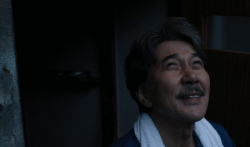Through skillful integration of art and science, Brazilian artist Denise Milan’s latest exhibition, Mist of the Earth, expertly depicts the importance of nature to humanity. This stunning exhibition, housed in Regents Hall 391, opened on Oct. 18 at Georgetown. In light of the human carelessness that threatens to destroy our environment, Milan has crafted four portfolios—“Paradise,” “Paradise Lost,” “Paradise Regained,” and “Cosmogenesis”—each of which illustrates a different aspect of her argument in defense of nature.
“Paradise” is an aesthetically beautiful collection that depicts the intrinsic and undying connection between nature and human beings. The collection is a series of photo collages, all of which include bright flora over dark backgrounds, and two of which, “Arasy” and “Tupa,” weave human images amid the plant life. “Arasy” features an infant and nursing mother with soft, red flowers cloaking her arms to symbolize the warm and gentle love that she offers to her child, a metaphor for Mother Nature’s role as both the source and the nurturer of human life.
The images of “Paradise Lost” place audiences at a much greater distance from the subject, an intentional shift from “Paradise.” The torn, faded landscapes appear as relics, a reminder that, faced by the vicious threat of human activity, nature may be permanently tarnished. The gold leaf that coats the space between photo fragments forces audiences to ponder the implications of human destruction. Perhaps the gold is the force pushing the images to shreds; the quest for expanding wealth neglects and destroys the natural world. The ambiguous gold woven into the landscapes indicates that nature is far more valuable than man-made riches. In “The Last Life,” the gold leaf conceals the majority of the landscape, symbolizing the trade-off between the two forms of earthly wealth. The gold and the grassland may be colored with the same, warm tone, but the textures are strikingly different, emphasizing the complexities of nature, which offer a deeper awareness than the monotonous greed of humanity. From the title to the composition, “Paradise Lost” delivers the solemn revelation of the course of environmental destruction that humans now struggle to reverse.
In response to the saddening cry of “Paradise Lost,” “Paradise Regained” offers a glimmer of hope and potential for change. In a captivating union of contrasts, images of flowers formed from crystals beautifully combine the living and nonliving, the rigid geometric structures together creating something more organic and fluid.
During a panel discussion regarding the exhibition, Milan explained what the crystals in “Paradise Regained” mean to her. The enduring perfection of crystals offers lessons of survival—lessons that she hopes people will take to heart and protect the Earth’s eternal beauty. The crystals, many of which formed alongside the planet Earth, have withstood the test of time, showcasing their beauty for a myriad of generations to come. If humans strive for conservation, then nature, too, may persevere.
The meaning of the flowers, however, is left open. Flowers emerge in the spring from the cold, bleak winter; flowers produce the seeds that enable the next generation of life. Panelist Peter Seligmann, Chairman and CEO of Conservation International, noted how “life begins and ends with flowers.” The flowers of “Paradise Regained” welcome a new birth, a departure from destructive ways, and the perpetuation of life. The final collection, “Cosmogenesis,” is by far the most abstract of the exhibition. The cloudy images stress movement over definitive form; each image is an instant in time, part of an ever-changing configuration. Of the four images, three are blue, the color of the sea, the sky, and the Earth when viewed from faraway space. One image ripples like the water from which life on Earth began. “Cosmogenesis” tells the story of the origin of life itself, a masterpiece that must be preserved.
“Cosmogenesis” is an analysis comprised of vague, blurry images that seek clarity on phenomena to which no human has borne witness. Panelist Jerome Friedman, MIT professor and Nobel Laureate in Physics for his discovery of quarks, explained that art and science are not opposites. Rather, they are two different methods for exploring the universe and striving to uncover meaning. “The only difference,” Friedman said, “is that science must provide a precise explanation, while art only needs to provide a general explanation.” Physics requires exact numbers to be true; art is true if it simply captures the essence of the phenomena. In this way, Milan’s work unveils deep truths about nature that science has yet to uncover. “Cosmogenesis” is an expression of exploration, curiosity, and discovery.
The meaning and significance of Milan’s work transcends the aesthetic of the exhibition room. The world is familiar with the data charting the destruction of life on Earth, yet billions of people refuse to change their ways. Milan’s artwork gives heart and soul to nature and the plaguing threats of civilization. During the panel, Seligmann noted how, for change to occur, we must seek to persuade not only minds, but souls. Even if Milan does not persuade every soul with her work, she will certainly garner attention.





